Foreign Exchange Risk Management Strategies for Xinjiang Company
VerifiedAdded on 2023/06/03
|12
|2521
|245
AI Summary
This article discusses the different risk management strategies for foreign exchange risk exposure and their justification for Xinjiang Company. It covers hedging through forward contracts, money market hedge, and option contracts. The article also includes calculations and analysis of the different strategies.
Contribute Materials
Your contribution can guide someone’s learning journey. Share your
documents today.

FIN61104 INDIVIDUAL ASSIGNMENT
Secure Best Marks with AI Grader
Need help grading? Try our AI Grader for instant feedback on your assignments.
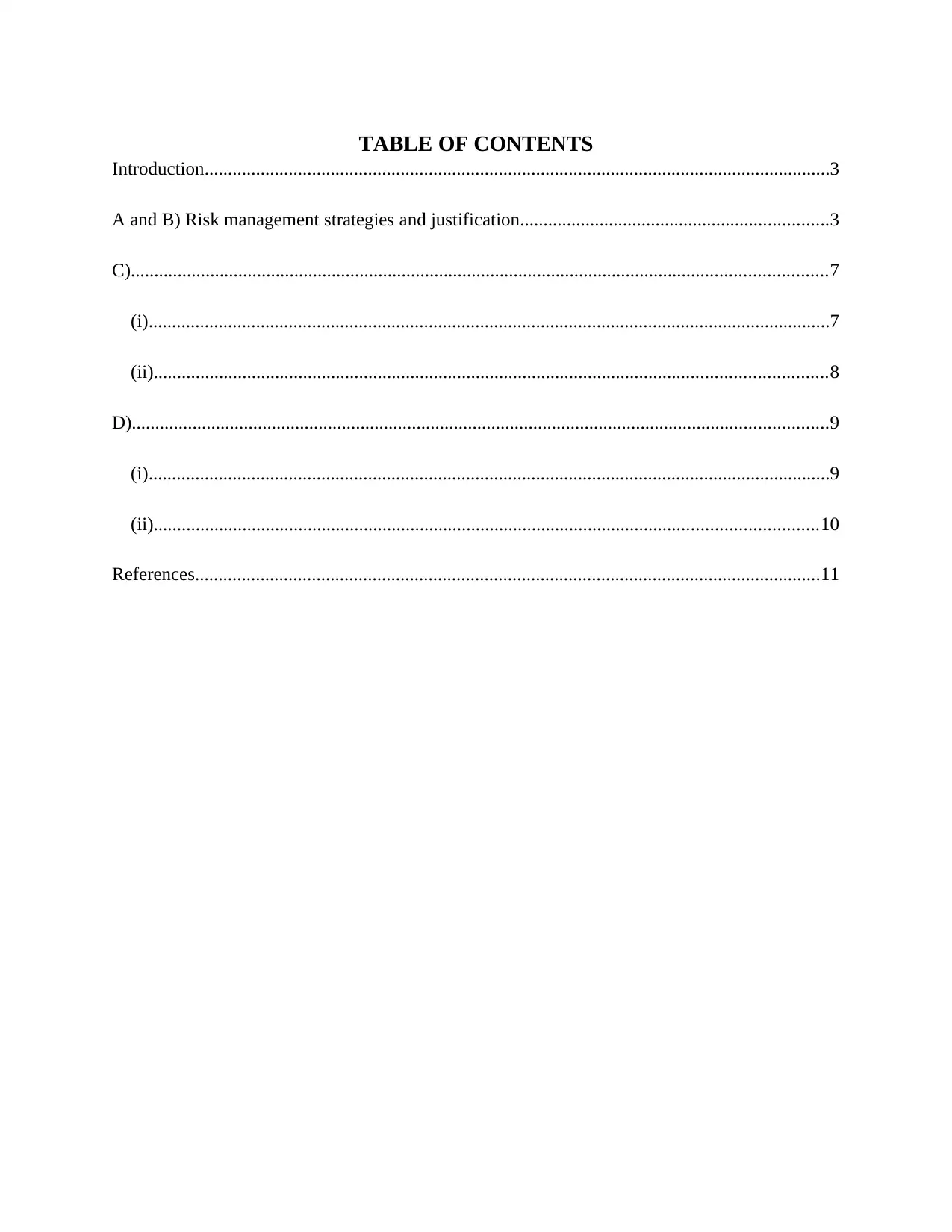
TABLE OF CONTENTS
Introduction......................................................................................................................................3
A and B) Risk management strategies and justification..................................................................3
C).....................................................................................................................................................7
(i)..................................................................................................................................................7
(ii)................................................................................................................................................8
D).....................................................................................................................................................9
(i)..................................................................................................................................................9
(ii)..............................................................................................................................................10
References......................................................................................................................................11
Introduction......................................................................................................................................3
A and B) Risk management strategies and justification..................................................................3
C).....................................................................................................................................................7
(i)..................................................................................................................................................7
(ii)................................................................................................................................................8
D).....................................................................................................................................................9
(i)..................................................................................................................................................9
(ii)..............................................................................................................................................10
References......................................................................................................................................11
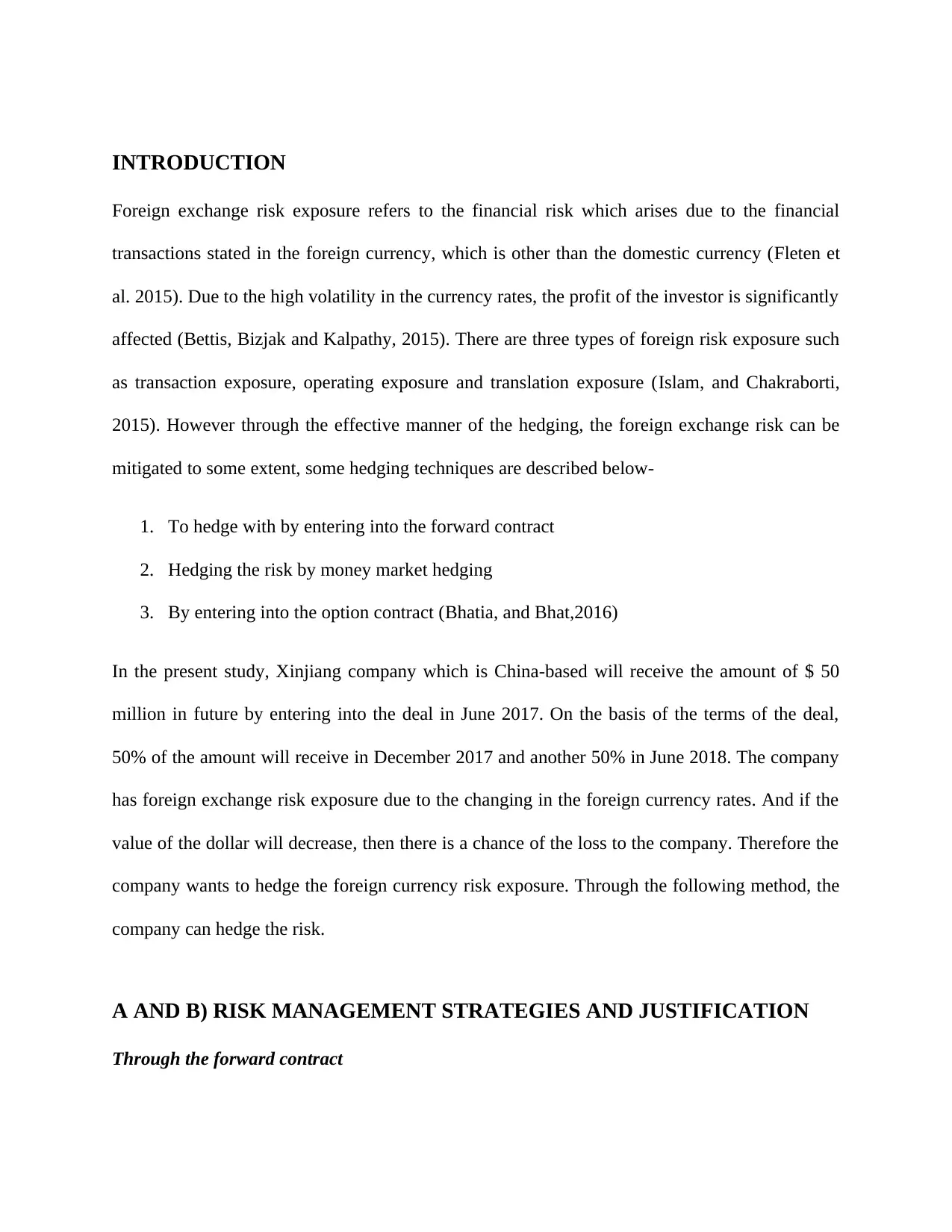
INTRODUCTION
Foreign exchange risk exposure refers to the financial risk which arises due to the financial
transactions stated in the foreign currency, which is other than the domestic currency (Fleten et
al. 2015). Due to the high volatility in the currency rates, the profit of the investor is significantly
affected (Bettis, Bizjak and Kalpathy, 2015). There are three types of foreign risk exposure such
as transaction exposure, operating exposure and translation exposure (Islam, and Chakraborti,
2015). However through the effective manner of the hedging, the foreign exchange risk can be
mitigated to some extent, some hedging techniques are described below-
1. To hedge with by entering into the forward contract
2. Hedging the risk by money market hedging
3. By entering into the option contract (Bhatia, and Bhat,2016)
In the present study, Xinjiang company which is China-based will receive the amount of $ 50
million in future by entering into the deal in June 2017. On the basis of the terms of the deal,
50% of the amount will receive in December 2017 and another 50% in June 2018. The company
has foreign exchange risk exposure due to the changing in the foreign currency rates. And if the
value of the dollar will decrease, then there is a chance of the loss to the company. Therefore the
company wants to hedge the foreign currency risk exposure. Through the following method, the
company can hedge the risk.
A AND B) RISK MANAGEMENT STRATEGIES AND JUSTIFICATION
Through the forward contract
Foreign exchange risk exposure refers to the financial risk which arises due to the financial
transactions stated in the foreign currency, which is other than the domestic currency (Fleten et
al. 2015). Due to the high volatility in the currency rates, the profit of the investor is significantly
affected (Bettis, Bizjak and Kalpathy, 2015). There are three types of foreign risk exposure such
as transaction exposure, operating exposure and translation exposure (Islam, and Chakraborti,
2015). However through the effective manner of the hedging, the foreign exchange risk can be
mitigated to some extent, some hedging techniques are described below-
1. To hedge with by entering into the forward contract
2. Hedging the risk by money market hedging
3. By entering into the option contract (Bhatia, and Bhat,2016)
In the present study, Xinjiang company which is China-based will receive the amount of $ 50
million in future by entering into the deal in June 2017. On the basis of the terms of the deal,
50% of the amount will receive in December 2017 and another 50% in June 2018. The company
has foreign exchange risk exposure due to the changing in the foreign currency rates. And if the
value of the dollar will decrease, then there is a chance of the loss to the company. Therefore the
company wants to hedge the foreign currency risk exposure. Through the following method, the
company can hedge the risk.
A AND B) RISK MANAGEMENT STRATEGIES AND JUSTIFICATION
Through the forward contract
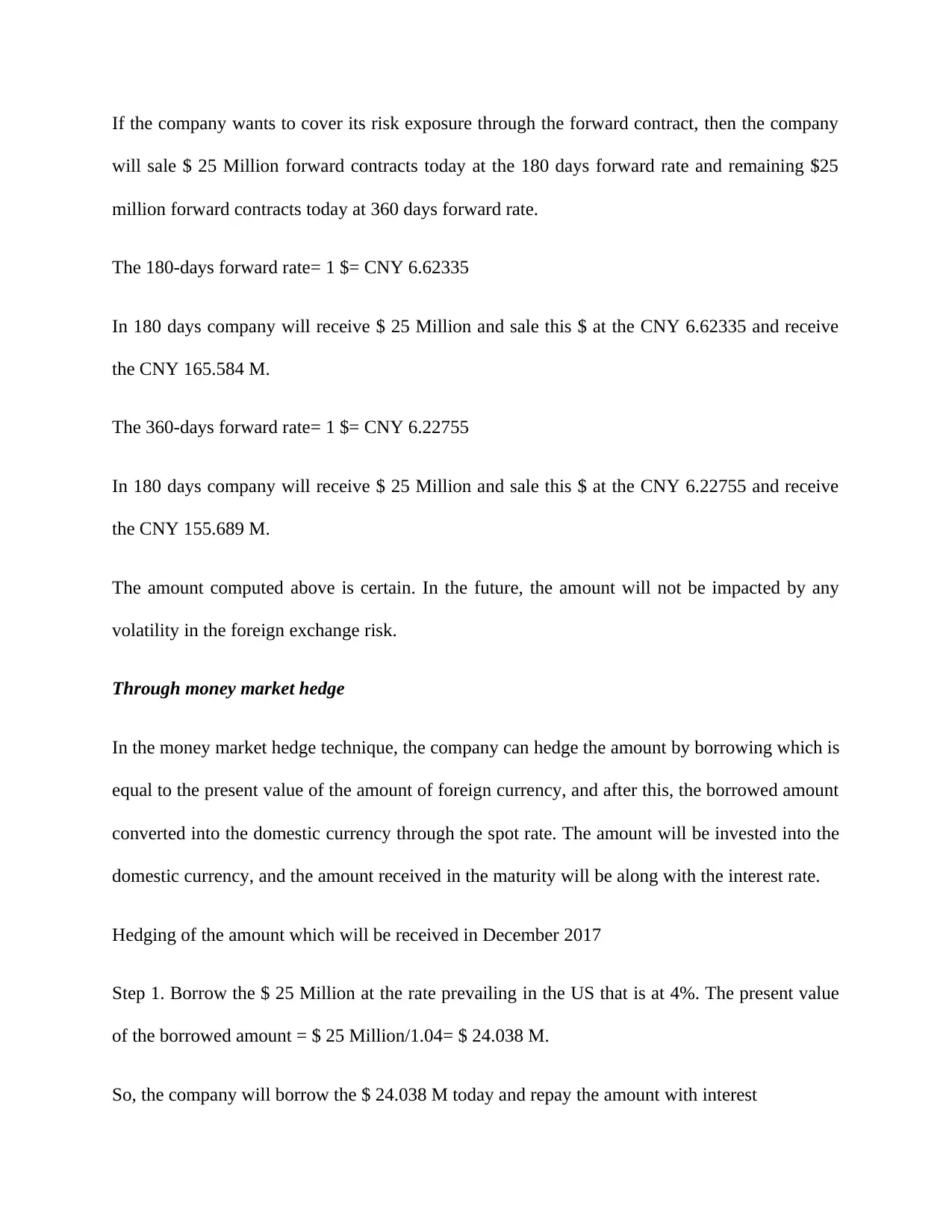
If the company wants to cover its risk exposure through the forward contract, then the company
will sale $ 25 Million forward contracts today at the 180 days forward rate and remaining $25
million forward contracts today at 360 days forward rate.
The 180-days forward rate= 1 $= CNY 6.62335
In 180 days company will receive $ 25 Million and sale this $ at the CNY 6.62335 and receive
the CNY 165.584 M.
The 360-days forward rate= 1 $= CNY 6.22755
In 180 days company will receive $ 25 Million and sale this $ at the CNY 6.22755 and receive
the CNY 155.689 M.
The amount computed above is certain. In the future, the amount will not be impacted by any
volatility in the foreign exchange risk.
Through money market hedge
In the money market hedge technique, the company can hedge the amount by borrowing which is
equal to the present value of the amount of foreign currency, and after this, the borrowed amount
converted into the domestic currency through the spot rate. The amount will be invested into the
domestic currency, and the amount received in the maturity will be along with the interest rate.
Hedging of the amount which will be received in December 2017
Step 1. Borrow the $ 25 Million at the rate prevailing in the US that is at 4%. The present value
of the borrowed amount = $ 25 Million/1.04= $ 24.038 M.
So, the company will borrow the $ 24.038 M today and repay the amount with interest
will sale $ 25 Million forward contracts today at the 180 days forward rate and remaining $25
million forward contracts today at 360 days forward rate.
The 180-days forward rate= 1 $= CNY 6.62335
In 180 days company will receive $ 25 Million and sale this $ at the CNY 6.62335 and receive
the CNY 165.584 M.
The 360-days forward rate= 1 $= CNY 6.22755
In 180 days company will receive $ 25 Million and sale this $ at the CNY 6.22755 and receive
the CNY 155.689 M.
The amount computed above is certain. In the future, the amount will not be impacted by any
volatility in the foreign exchange risk.
Through money market hedge
In the money market hedge technique, the company can hedge the amount by borrowing which is
equal to the present value of the amount of foreign currency, and after this, the borrowed amount
converted into the domestic currency through the spot rate. The amount will be invested into the
domestic currency, and the amount received in the maturity will be along with the interest rate.
Hedging of the amount which will be received in December 2017
Step 1. Borrow the $ 25 Million at the rate prevailing in the US that is at 4%. The present value
of the borrowed amount = $ 25 Million/1.04= $ 24.038 M.
So, the company will borrow the $ 24.038 M today and repay the amount with interest
Secure Best Marks with AI Grader
Need help grading? Try our AI Grader for instant feedback on your assignments.
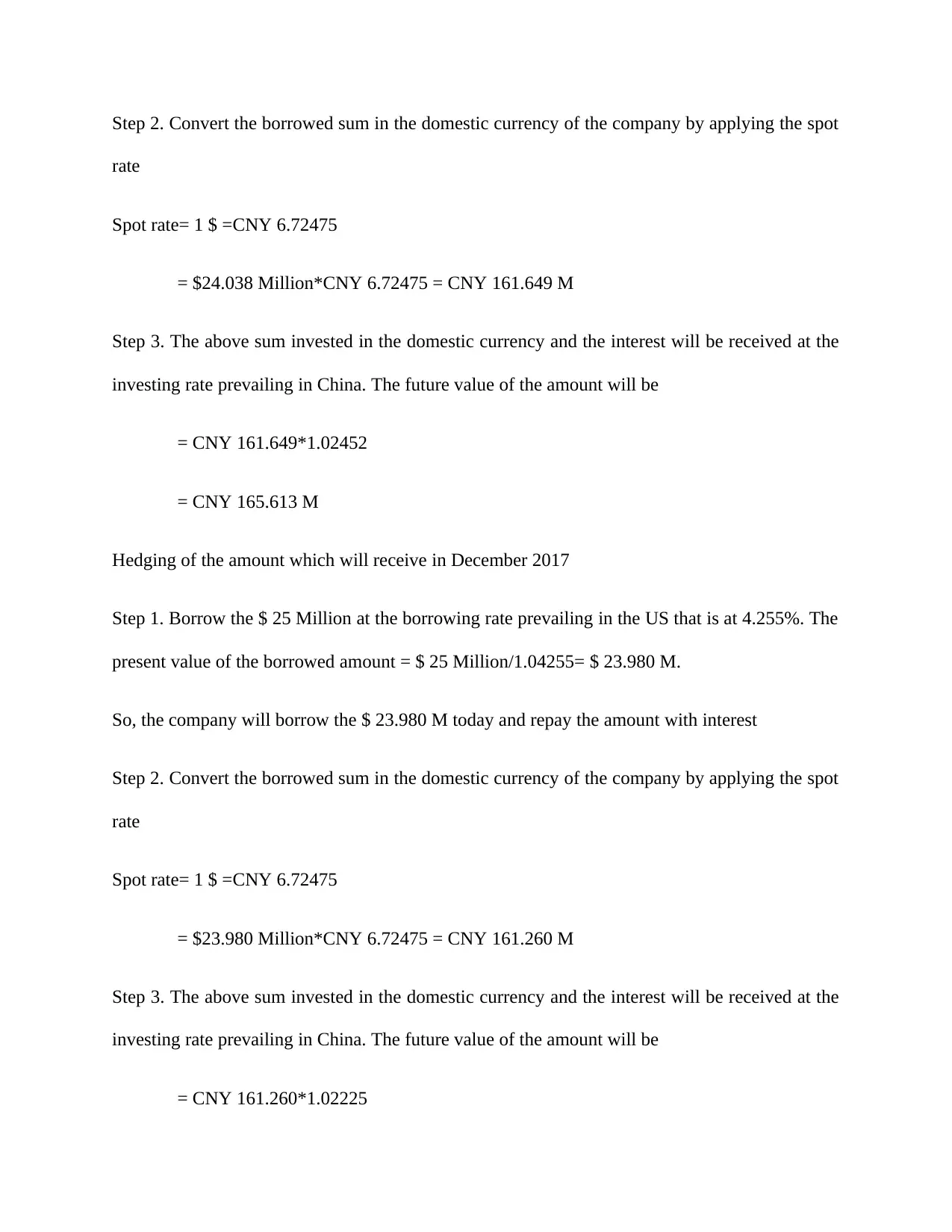
Step 2. Convert the borrowed sum in the domestic currency of the company by applying the spot
rate
Spot rate= 1 $ =CNY 6.72475
= $24.038 Million*CNY 6.72475 = CNY 161.649 M
Step 3. The above sum invested in the domestic currency and the interest will be received at the
investing rate prevailing in China. The future value of the amount will be
= CNY 161.649*1.02452
= CNY 165.613 M
Hedging of the amount which will receive in December 2017
Step 1. Borrow the $ 25 Million at the borrowing rate prevailing in the US that is at 4.255%. The
present value of the borrowed amount = $ 25 Million/1.04255= $ 23.980 M.
So, the company will borrow the $ 23.980 M today and repay the amount with interest
Step 2. Convert the borrowed sum in the domestic currency of the company by applying the spot
rate
Spot rate= 1 $ =CNY 6.72475
= $23.980 Million*CNY 6.72475 = CNY 161.260 M
Step 3. The above sum invested in the domestic currency and the interest will be received at the
investing rate prevailing in China. The future value of the amount will be
= CNY 161.260*1.02225
rate
Spot rate= 1 $ =CNY 6.72475
= $24.038 Million*CNY 6.72475 = CNY 161.649 M
Step 3. The above sum invested in the domestic currency and the interest will be received at the
investing rate prevailing in China. The future value of the amount will be
= CNY 161.649*1.02452
= CNY 165.613 M
Hedging of the amount which will receive in December 2017
Step 1. Borrow the $ 25 Million at the borrowing rate prevailing in the US that is at 4.255%. The
present value of the borrowed amount = $ 25 Million/1.04255= $ 23.980 M.
So, the company will borrow the $ 23.980 M today and repay the amount with interest
Step 2. Convert the borrowed sum in the domestic currency of the company by applying the spot
rate
Spot rate= 1 $ =CNY 6.72475
= $23.980 Million*CNY 6.72475 = CNY 161.260 M
Step 3. The above sum invested in the domestic currency and the interest will be received at the
investing rate prevailing in China. The future value of the amount will be
= CNY 161.260*1.02225
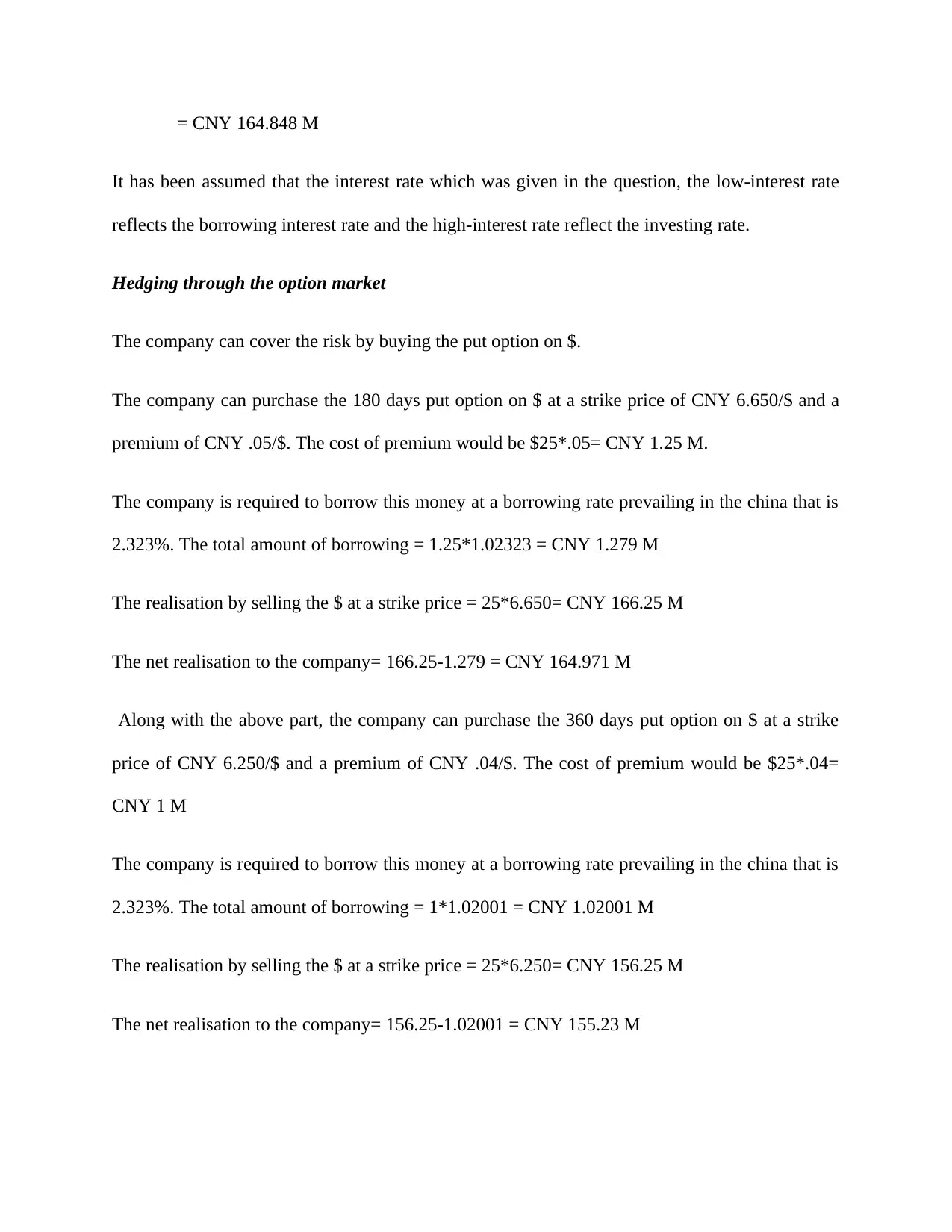
= CNY 164.848 M
It has been assumed that the interest rate which was given in the question, the low-interest rate
reflects the borrowing interest rate and the high-interest rate reflect the investing rate.
Hedging through the option market
The company can cover the risk by buying the put option on $.
The company can purchase the 180 days put option on $ at a strike price of CNY 6.650/$ and a
premium of CNY .05/$. The cost of premium would be $25*.05= CNY 1.25 M.
The company is required to borrow this money at a borrowing rate prevailing in the china that is
2.323%. The total amount of borrowing = 1.25*1.02323 = CNY 1.279 M
The realisation by selling the $ at a strike price = 25*6.650= CNY 166.25 M
The net realisation to the company= 166.25-1.279 = CNY 164.971 M
Along with the above part, the company can purchase the 360 days put option on $ at a strike
price of CNY 6.250/$ and a premium of CNY .04/$. The cost of premium would be $25*.04=
CNY 1 M
The company is required to borrow this money at a borrowing rate prevailing in the china that is
2.323%. The total amount of borrowing = 1*1.02001 = CNY 1.02001 M
The realisation by selling the $ at a strike price = 25*6.250= CNY 156.25 M
The net realisation to the company= 156.25-1.02001 = CNY 155.23 M
It has been assumed that the interest rate which was given in the question, the low-interest rate
reflects the borrowing interest rate and the high-interest rate reflect the investing rate.
Hedging through the option market
The company can cover the risk by buying the put option on $.
The company can purchase the 180 days put option on $ at a strike price of CNY 6.650/$ and a
premium of CNY .05/$. The cost of premium would be $25*.05= CNY 1.25 M.
The company is required to borrow this money at a borrowing rate prevailing in the china that is
2.323%. The total amount of borrowing = 1.25*1.02323 = CNY 1.279 M
The realisation by selling the $ at a strike price = 25*6.650= CNY 166.25 M
The net realisation to the company= 166.25-1.279 = CNY 164.971 M
Along with the above part, the company can purchase the 360 days put option on $ at a strike
price of CNY 6.250/$ and a premium of CNY .04/$. The cost of premium would be $25*.04=
CNY 1 M
The company is required to borrow this money at a borrowing rate prevailing in the china that is
2.323%. The total amount of borrowing = 1*1.02001 = CNY 1.02001 M
The realisation by selling the $ at a strike price = 25*6.250= CNY 156.25 M
The net realisation to the company= 156.25-1.02001 = CNY 155.23 M
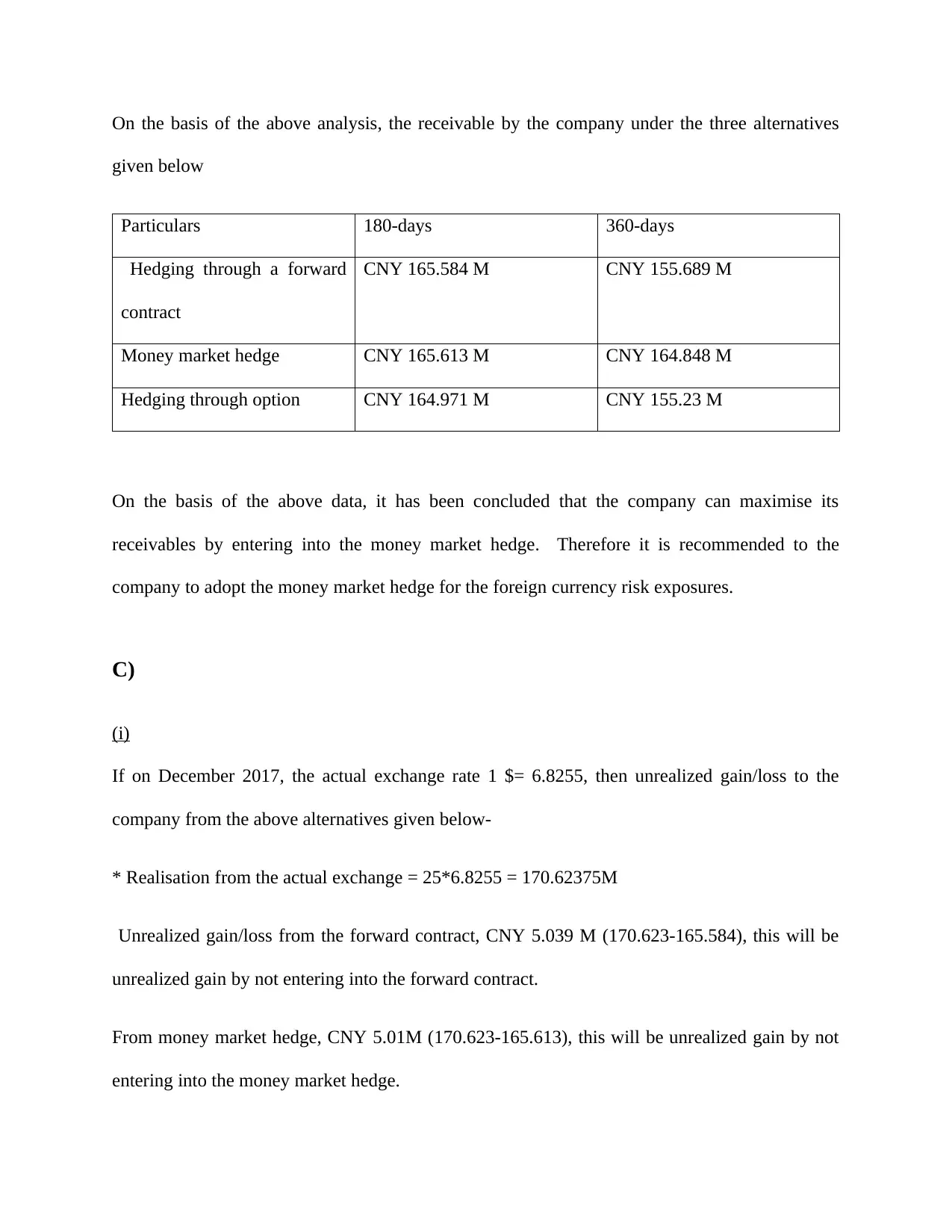
On the basis of the above analysis, the receivable by the company under the three alternatives
given below
Particulars 180-days 360-days
Hedging through a forward
contract
CNY 165.584 M CNY 155.689 M
Money market hedge CNY 165.613 M CNY 164.848 M
Hedging through option CNY 164.971 M CNY 155.23 M
On the basis of the above data, it has been concluded that the company can maximise its
receivables by entering into the money market hedge. Therefore it is recommended to the
company to adopt the money market hedge for the foreign currency risk exposures.
C)
(i)
If on December 2017, the actual exchange rate 1 $= 6.8255, then unrealized gain/loss to the
company from the above alternatives given below-
* Realisation from the actual exchange = 25*6.8255 = 170.62375M
Unrealized gain/loss from the forward contract, CNY 5.039 M (170.623-165.584), this will be
unrealized gain by not entering into the forward contract.
From money market hedge, CNY 5.01M (170.623-165.613), this will be unrealized gain by not
entering into the money market hedge.
given below
Particulars 180-days 360-days
Hedging through a forward
contract
CNY 165.584 M CNY 155.689 M
Money market hedge CNY 165.613 M CNY 164.848 M
Hedging through option CNY 164.971 M CNY 155.23 M
On the basis of the above data, it has been concluded that the company can maximise its
receivables by entering into the money market hedge. Therefore it is recommended to the
company to adopt the money market hedge for the foreign currency risk exposures.
C)
(i)
If on December 2017, the actual exchange rate 1 $= 6.8255, then unrealized gain/loss to the
company from the above alternatives given below-
* Realisation from the actual exchange = 25*6.8255 = 170.62375M
Unrealized gain/loss from the forward contract, CNY 5.039 M (170.623-165.584), this will be
unrealized gain by not entering into the forward contract.
From money market hedge, CNY 5.01M (170.623-165.613), this will be unrealized gain by not
entering into the money market hedge.
Paraphrase This Document
Need a fresh take? Get an instant paraphrase of this document with our AI Paraphraser
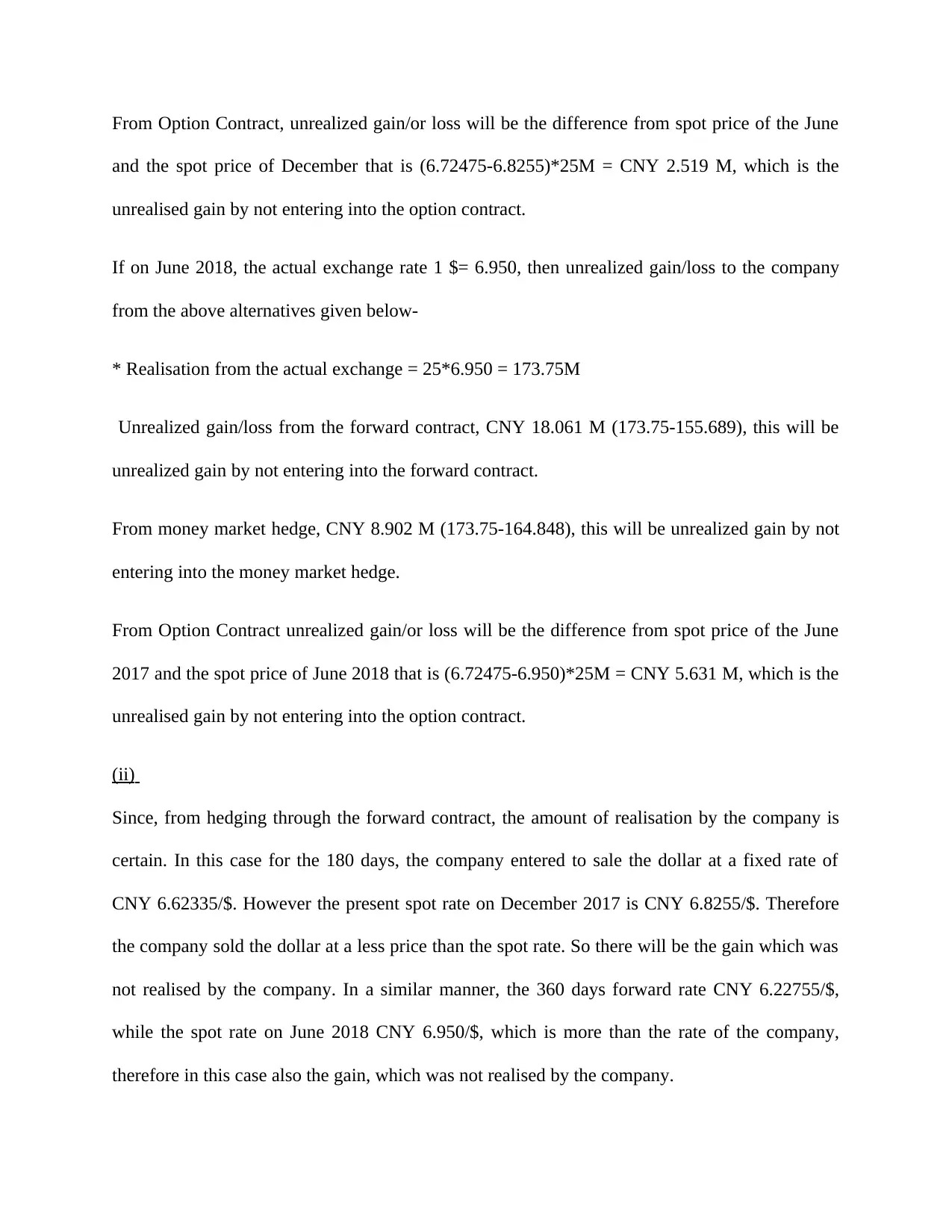
From Option Contract, unrealized gain/or loss will be the difference from spot price of the June
and the spot price of December that is (6.72475-6.8255)*25M = CNY 2.519 M, which is the
unrealised gain by not entering into the option contract.
If on June 2018, the actual exchange rate 1 $= 6.950, then unrealized gain/loss to the company
from the above alternatives given below-
* Realisation from the actual exchange = 25*6.950 = 173.75M
Unrealized gain/loss from the forward contract, CNY 18.061 M (173.75-155.689), this will be
unrealized gain by not entering into the forward contract.
From money market hedge, CNY 8.902 M (173.75-164.848), this will be unrealized gain by not
entering into the money market hedge.
From Option Contract unrealized gain/or loss will be the difference from spot price of the June
2017 and the spot price of June 2018 that is (6.72475-6.950)*25M = CNY 5.631 M, which is the
unrealised gain by not entering into the option contract.
(ii)
Since, from hedging through the forward contract, the amount of realisation by the company is
certain. In this case for the 180 days, the company entered to sale the dollar at a fixed rate of
CNY 6.62335/$. However the present spot rate on December 2017 is CNY 6.8255/$. Therefore
the company sold the dollar at a less price than the spot rate. So there will be the gain which was
not realised by the company. In a similar manner, the 360 days forward rate CNY 6.22755/$,
while the spot rate on June 2018 CNY 6.950/$, which is more than the rate of the company,
therefore in this case also the gain, which was not realised by the company.
and the spot price of December that is (6.72475-6.8255)*25M = CNY 2.519 M, which is the
unrealised gain by not entering into the option contract.
If on June 2018, the actual exchange rate 1 $= 6.950, then unrealized gain/loss to the company
from the above alternatives given below-
* Realisation from the actual exchange = 25*6.950 = 173.75M
Unrealized gain/loss from the forward contract, CNY 18.061 M (173.75-155.689), this will be
unrealized gain by not entering into the forward contract.
From money market hedge, CNY 8.902 M (173.75-164.848), this will be unrealized gain by not
entering into the money market hedge.
From Option Contract unrealized gain/or loss will be the difference from spot price of the June
2017 and the spot price of June 2018 that is (6.72475-6.950)*25M = CNY 5.631 M, which is the
unrealised gain by not entering into the option contract.
(ii)
Since, from hedging through the forward contract, the amount of realisation by the company is
certain. In this case for the 180 days, the company entered to sale the dollar at a fixed rate of
CNY 6.62335/$. However the present spot rate on December 2017 is CNY 6.8255/$. Therefore
the company sold the dollar at a less price than the spot rate. So there will be the gain which was
not realised by the company. In a similar manner, the 360 days forward rate CNY 6.22755/$,
while the spot rate on June 2018 CNY 6.950/$, which is more than the rate of the company,
therefore in this case also the gain, which was not realised by the company.
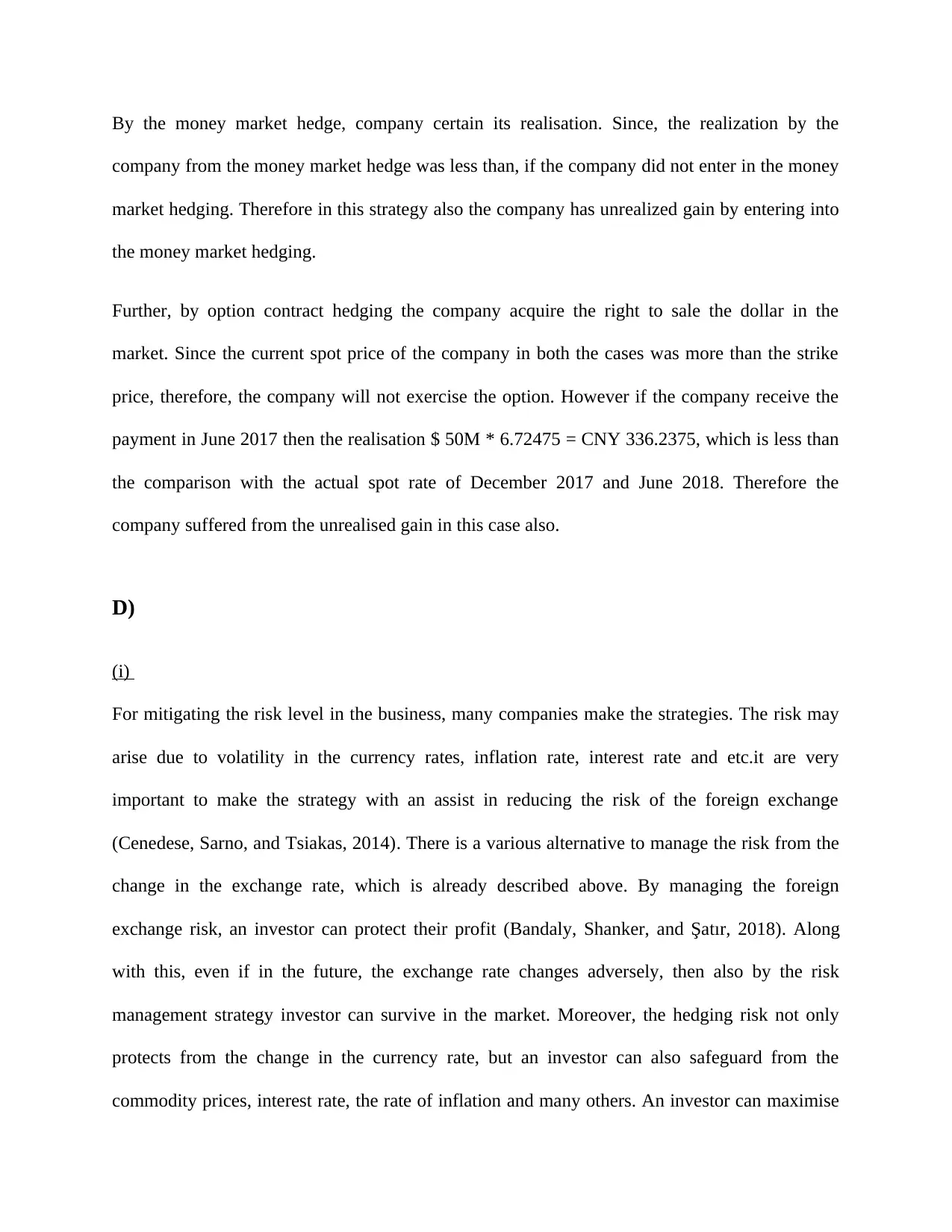
By the money market hedge, company certain its realisation. Since, the realization by the
company from the money market hedge was less than, if the company did not enter in the money
market hedging. Therefore in this strategy also the company has unrealized gain by entering into
the money market hedging.
Further, by option contract hedging the company acquire the right to sale the dollar in the
market. Since the current spot price of the company in both the cases was more than the strike
price, therefore, the company will not exercise the option. However if the company receive the
payment in June 2017 then the realisation $ 50M * 6.72475 = CNY 336.2375, which is less than
the comparison with the actual spot rate of December 2017 and June 2018. Therefore the
company suffered from the unrealised gain in this case also.
D)
(i)
For mitigating the risk level in the business, many companies make the strategies. The risk may
arise due to volatility in the currency rates, inflation rate, interest rate and etc.it are very
important to make the strategy with an assist in reducing the risk of the foreign exchange
(Cenedese, Sarno, and Tsiakas, 2014). There is a various alternative to manage the risk from the
change in the exchange rate, which is already described above. By managing the foreign
exchange risk, an investor can protect their profit (Bandaly, Shanker, and Şatır, 2018). Along
with this, even if in the future, the exchange rate changes adversely, then also by the risk
management strategy investor can survive in the market. Moreover, the hedging risk not only
protects from the change in the currency rate, but an investor can also safeguard from the
commodity prices, interest rate, the rate of inflation and many others. An investor can maximise
company from the money market hedge was less than, if the company did not enter in the money
market hedging. Therefore in this strategy also the company has unrealized gain by entering into
the money market hedging.
Further, by option contract hedging the company acquire the right to sale the dollar in the
market. Since the current spot price of the company in both the cases was more than the strike
price, therefore, the company will not exercise the option. However if the company receive the
payment in June 2017 then the realisation $ 50M * 6.72475 = CNY 336.2375, which is less than
the comparison with the actual spot rate of December 2017 and June 2018. Therefore the
company suffered from the unrealised gain in this case also.
D)
(i)
For mitigating the risk level in the business, many companies make the strategies. The risk may
arise due to volatility in the currency rates, inflation rate, interest rate and etc.it are very
important to make the strategy with an assist in reducing the risk of the foreign exchange
(Cenedese, Sarno, and Tsiakas, 2014). There is a various alternative to manage the risk from the
change in the exchange rate, which is already described above. By managing the foreign
exchange risk, an investor can protect their profit (Bandaly, Shanker, and Şatır, 2018). Along
with this, even if in the future, the exchange rate changes adversely, then also by the risk
management strategy investor can survive in the market. Moreover, the hedging risk not only
protects from the change in the currency rate, but an investor can also safeguard from the
commodity prices, interest rate, the rate of inflation and many others. An investor can maximise

its profit by managing the risk. Although there is some cost involved in managing the risk, this
cost can easily cover by the profit from the investment (Apergis, and Artikis, 2016).
On the other side, if the investor does not make an effort to manage the foreign exchange risk,
then the investor has possessed so many risks due to the change in the market condition. Since
the change in the currency rate, interest rate, inflation rate, it is very typical to measure the
change in the future. Therefore in any case, if the condition of the market moves adverse with the
investment, then the chances of loss will very significant impact to the investor (Chong, Chang,
and Tan, 2014). So, it is worth full for the investor to make the efforts for managing the risk due
to the foreign exchange
(ii)
If the company remain unhedged, then the company sell the $ 25 Million at the spot price of
December 2017 and another $ 25 Million at the spot rate on the date of June 2018.
Realisation on December 2017 = $ 25 M * 6.8255 = CNY 170.6375
Realisation on June 2018 = $ 25M *6.950= CNY 173.75
On the basis of the above calculation, it has been seen that the company, if not adopt any hedging
alternative than obtaining the more realisation by selling the dollar at the spot prices.
cost can easily cover by the profit from the investment (Apergis, and Artikis, 2016).
On the other side, if the investor does not make an effort to manage the foreign exchange risk,
then the investor has possessed so many risks due to the change in the market condition. Since
the change in the currency rate, interest rate, inflation rate, it is very typical to measure the
change in the future. Therefore in any case, if the condition of the market moves adverse with the
investment, then the chances of loss will very significant impact to the investor (Chong, Chang,
and Tan, 2014). So, it is worth full for the investor to make the efforts for managing the risk due
to the foreign exchange
(ii)
If the company remain unhedged, then the company sell the $ 25 Million at the spot price of
December 2017 and another $ 25 Million at the spot rate on the date of June 2018.
Realisation on December 2017 = $ 25 M * 6.8255 = CNY 170.6375
Realisation on June 2018 = $ 25M *6.950= CNY 173.75
On the basis of the above calculation, it has been seen that the company, if not adopt any hedging
alternative than obtaining the more realisation by selling the dollar at the spot prices.
Secure Best Marks with AI Grader
Need help grading? Try our AI Grader for instant feedback on your assignments.
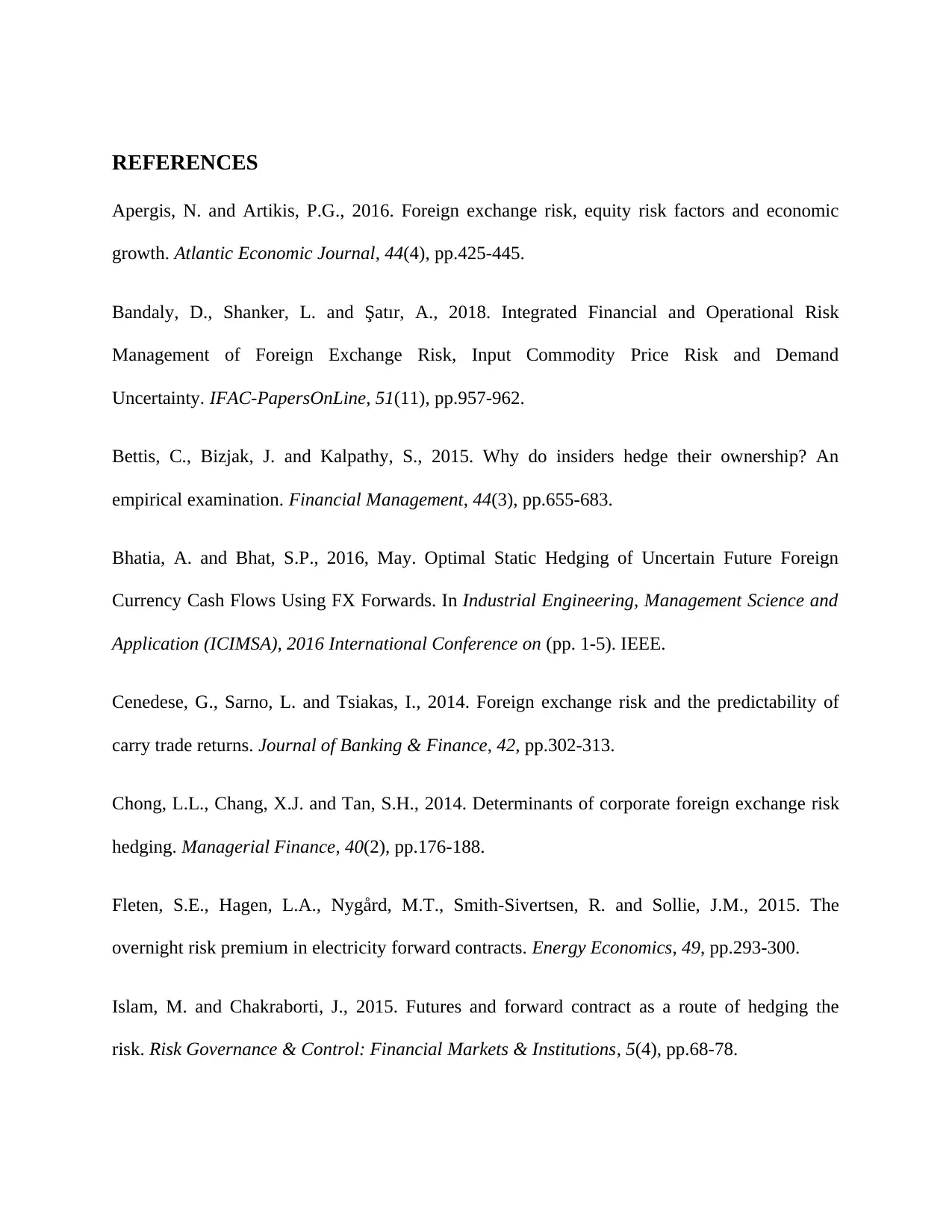
REFERENCES
Apergis, N. and Artikis, P.G., 2016. Foreign exchange risk, equity risk factors and economic
growth. Atlantic Economic Journal, 44(4), pp.425-445.
Bandaly, D., Shanker, L. and Şatır, A., 2018. Integrated Financial and Operational Risk
Management of Foreign Exchange Risk, Input Commodity Price Risk and Demand
Uncertainty. IFAC-PapersOnLine, 51(11), pp.957-962.
Bettis, C., Bizjak, J. and Kalpathy, S., 2015. Why do insiders hedge their ownership? An
empirical examination. Financial Management, 44(3), pp.655-683.
Bhatia, A. and Bhat, S.P., 2016, May. Optimal Static Hedging of Uncertain Future Foreign
Currency Cash Flows Using FX Forwards. In Industrial Engineering, Management Science and
Application (ICIMSA), 2016 International Conference on (pp. 1-5). IEEE.
Cenedese, G., Sarno, L. and Tsiakas, I., 2014. Foreign exchange risk and the predictability of
carry trade returns. Journal of Banking & Finance, 42, pp.302-313.
Chong, L.L., Chang, X.J. and Tan, S.H., 2014. Determinants of corporate foreign exchange risk
hedging. Managerial Finance, 40(2), pp.176-188.
Fleten, S.E., Hagen, L.A., Nygård, M.T., Smith-Sivertsen, R. and Sollie, J.M., 2015. The
overnight risk premium in electricity forward contracts. Energy Economics, 49, pp.293-300.
Islam, M. and Chakraborti, J., 2015. Futures and forward contract as a route of hedging the
risk. Risk Governance & Control: Financial Markets & Institutions, 5(4), pp.68-78.
Apergis, N. and Artikis, P.G., 2016. Foreign exchange risk, equity risk factors and economic
growth. Atlantic Economic Journal, 44(4), pp.425-445.
Bandaly, D., Shanker, L. and Şatır, A., 2018. Integrated Financial and Operational Risk
Management of Foreign Exchange Risk, Input Commodity Price Risk and Demand
Uncertainty. IFAC-PapersOnLine, 51(11), pp.957-962.
Bettis, C., Bizjak, J. and Kalpathy, S., 2015. Why do insiders hedge their ownership? An
empirical examination. Financial Management, 44(3), pp.655-683.
Bhatia, A. and Bhat, S.P., 2016, May. Optimal Static Hedging of Uncertain Future Foreign
Currency Cash Flows Using FX Forwards. In Industrial Engineering, Management Science and
Application (ICIMSA), 2016 International Conference on (pp. 1-5). IEEE.
Cenedese, G., Sarno, L. and Tsiakas, I., 2014. Foreign exchange risk and the predictability of
carry trade returns. Journal of Banking & Finance, 42, pp.302-313.
Chong, L.L., Chang, X.J. and Tan, S.H., 2014. Determinants of corporate foreign exchange risk
hedging. Managerial Finance, 40(2), pp.176-188.
Fleten, S.E., Hagen, L.A., Nygård, M.T., Smith-Sivertsen, R. and Sollie, J.M., 2015. The
overnight risk premium in electricity forward contracts. Energy Economics, 49, pp.293-300.
Islam, M. and Chakraborti, J., 2015. Futures and forward contract as a route of hedging the
risk. Risk Governance & Control: Financial Markets & Institutions, 5(4), pp.68-78.

1 out of 12
Related Documents
Your All-in-One AI-Powered Toolkit for Academic Success.
+13062052269
info@desklib.com
Available 24*7 on WhatsApp / Email
![[object Object]](/_next/static/media/star-bottom.7253800d.svg)
Unlock your academic potential
© 2024 | Zucol Services PVT LTD | All rights reserved.





